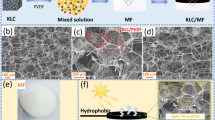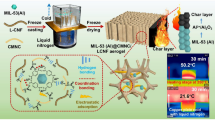Abstract
The application potential of nanocellulose has been previously hindered by the costly and slow drying methods that this material requires, including freeze/supercritical drying process. The main issue for nanocellulose commercialization is how effectively and rapidly its high water contents (90–99%) can be removed, all of which raise its transportation and processing costs. Oven-drying is the fastest, most economical, and most scalable method for dehydrating nanocellulose, but causes strong interfibrillar aggregation and leads to poor aqueous re-dispersion. Here, we report that the problems of nanocellulose oven-drying are comprehensively overcome by adding tert-butanol (t-BuOH) to the nanocellulose solution at >90%. In a lab-scale comparison, the t-BuOH-mediated oven-drying of aqueous nanocellulose showed lower drying times by a factor of 2–12 compared to water only oven-drying and freeze drying of the same material. The dispersibility of this dried nanocellulose is as high as the never-dried material in terms of particle size, light transmittance, and sedimentation. t-BuOH reduces interfibrillar shrinkage due to the lower surface tension of t-BuOH compared to water, and a remaining t-BuOH/water mixture decreases interfibrillar adhesion and contact.

This paper suggests a strategy to improve the aqueous re-dispersibility of oven-dried nanocellulose, and to accelerate oven-drying rate.








Similar content being viewed by others
References
Habibi Y (2014) Key advances in the chemical modification of nanocelluloses. Chem Soc Rev 43:1519–1542
Dong S, Roman M (2007) Fluorescently labeled cellulose nanocrystals for bioimaging applications. J Am Chem Soc 129:13810–13811
Fukuzumi H, Saito T, Iwata T, Kumamoto Y, Isogai A (2009) Transparent and high gas barrier films of cellulose nanofibers prepared by tempo-mediated oxidation. Biomacromolecules 10:162–165
Li W, Zhao X, Huang Z, Liu S (2013) Nanocellulose fibrils isolated from BHKP using ultrasonication and their reinforcing properties in transparent poly(vinyl alcohol) films. J Polym Res 20:210–216
Saito T, Uematsu T, Kimura S, Enomae T, Isogai A (2011) Self-aligned integration of native cellulose nanofibrils towards producing diverse bulk materials. Soft Matter 7:8804–8809
Lu B, Lin F, Jiang X, Cheng J, Lu Q, Song J, Chen C, Huang B (2017) One-pot assembly of microfibrillated cellulose reinforced pva–borax hydrogels with self-healing and ph-responsive properties. ACS Sustain Chem Eng 5:948–956
Saito T, Kuramae R, Wohlert J, Berglund LA, Isogai A (2013) An ultrastrong nanofibrillar biomaterial: the strength of single cellulose nanofibrils revealed via sonication-induced fragmentation. Biomacromolecules 14:248–253
Mi Q, Ma S, Yu J, He J, Zhang J (2016) Flexible and transparent cellulose aerogels with uniform nanoporous structure by a controlled regeneration process. ACS Sustain Chem Eng 4:656–660
Nguyen HL, Jo YK, Cha M, Cha YJ, Yoon DK, Sanandiya ND, Prajatelistia E, Oh DX, Hwang DS (2016) Mussel-inspired anisotropic nanocellulose and silver nanoparticle composite with improved mechanical properties, electrical conductivity and antibacterial activity. Polymers (Basel) 8:102–114
Thielemans W, Warbey CR, Walsh DA (2009) Permselective nanostructured membranes based on cellulose nanowhiskers. Green Chem 11:531–537
Sehaqui H, Mushi NE, Morimune S, Salajkova M, Nishino T, Berglund LA (2012) Cellulose nanofiber orientation in nanopaper and nanocomposites by cold drawing. ACS Appl Mater Interfaces 4:1043–1049
Peng Y, Gardner DJ, Han Y (2012) Drying cellulose nanofibrils: in search of a suitable method. Cellulose 19:91–102
Beck S, Bouchard J, Berry R (2012) Dispersibility in water of dried nanocrystalline cellulose. Biomacromolecules 13:1486–1494
Ávila HM, Feldmann EM, Pleumeekers MM, Nimeskern L, Kuo W, de Jong WC, Schwarz S, Müller R, Hendriks J, Rotter N, van Osch GJ, Stok KS, Gatenholm P (2015) Novel bilayer bacterial nanocellulose scaffold supports neocartilage formation in vitro and in vivo. Biomaterials 44:122–133
Lee DJ, Jangam S, Mujumdar AS (2013) Some recent advances in drying technologies to produce particulate solids. KONA Powder Part J 30:69–83
Korhonen JT, Hiekkataipale P, Malm J, Karppinen M, Ikkala O, Ras RH (2011) Inorganic hollow nanotube aerogels by atomic layer deposition onto native nanocellulose templates. ACS Nano 5:1967–1974
Nakasaka Y, Yoshikawa T, Kawamata Y, Tago T, Sato S, Takanohashi T, Koyama Y, Masuda T (2017) Fractonation of degraded lignin by using a water/1-butanol mixture with a solid-acid catalyst: A potential sources of phenolic compounds. ChemCatChem 9:2875–2880
Feng J, Hsieh Y-L (2014) Assembling and redispersibility of rice straw nanocellulose: Effect of tert-butanol. ACS Appl Mater Interfaces 6:20075–20084
Nemoto J, Saito T, Isogai A (2015) Simple freeze-drying procedure for producing nanocellulose aerogel-containing, high-performance air filters. ACS Appl Mater Interfaces 7:19809–19815
Chen Y, Dutta S, K-W W (2014) Integrated, cascading enzyme−/chemocatalytic cellulose conversion using catalysts based on mesoporous silica nanoparticles. ChemSusChem 7:3241–3246
Dutta S, K-W W (2014) Enzymatic breakdown of biomass: enzyme active sites, immobilization, and biofuel production. Green Chem 16:4615–4626
Dutta S, Bhaumik A, K-W W (2014) Hierarchically porous carbon derived from polymers and biomass: effect of interconnected pores on energy applications. Energy Environ Sci 7:3574–3592
Lee Y, Chen C, Chiu Y, K-W W (2013) An effective cellulose-to-glucose-to-fructose conversion sequence by using enzyme immobilized Fe3O4-loaded mesoporous silica nanoparticles as recyclable biocatalysts. ChemCatChem 5:2153–2157
Alam MI, De S, Singh B, Saha B, Abu-Omar MM (2014) Titanium hydrogenphosphaste: An efficient dual acidic catalyst for 5-hydroxymethylfurfural (HMF) production. Appl Catal, A 486:42–48
Jeong G, Ra CH, Hong Y, Kim JK, Song I, Kim S, Park D (2015) Conversion of red-algae Gracilaria verrucosa to sugars, levulinic acid and 5-hydroxymethylfurfural. Bioprocess Biosyst Eng 38:207–217
Kuo I, Suzuki N, Yamauchi Y, K-W W (2013) Cellulose-to-HMF conversion using crystalline mesoporous titania and zirconia nanocatalysts in ionic liquid suystems. RSC Adv 3:2028–2034
Hsu W, Lee Y, Peng W, K-W W (2011) Cellulosic cenversion in ionic liquids (ILs): Effects of H2O/cellulose molar ratios, temperatures, times, and different ILs on the production of monosaccharides and 5-hydroxymethylfurfural (HMF). Catal Today 174:65–69
Peng Y, Gardner DJ, Han Y, Kiziltas A, Cai Z, Tshabalala MA (2013) Influence of drying method on the material properties of nanocellulose I: thermostability and crystallinity. Cellulose 20:2379–2392
Scherer GW (1990) Theory of Drying. J Am Ceram Soc 73:3–14
Sehaqui H, Zhou Q, Berglund LA (2011) High-porosity aerogels of high specific surface area prepared from nanofibrillated cellulose (NFC). Compos Sci Technol 71:1593–1599
Gardner DJ, Oporto GS, Mills R, Samir MASA (2008) Adhesion and Surface Issues in Cellulose and Nanocellulose. J Adhes Sci Technol 22:545–567
Lewis L, Derakhshandeh M, Hatzikiriakos SG, Hamad WY, MacLachlan MJ (2016) Hydrothermal gelation of aqueous cellulose nanocrystal suspensions. Biomacromolecules 17:2747–2754
Saito T, Isogai A (2006) Introduction of aldehyde groups on surfaces of native cellulose fibers by TEMPO-mediated oxidation. Colloids Surf A Physicochem Eng Asp 289:219–225
Jaušovec D, Vogrinčič R, Kokol V (2015) Introduction of aldehyde vs. carboxylic groups to cellulose nanofibers using laccase/TEMPO mediated oxidation. Carbohydr Polym 116:74–85
Agustin MB, Nakatsubo F, Yano H (2017) Improved resistance of chemically-modified nanocellulose against thermally-induced depolymerization. Carbohydr Polym 164:1–7
Zhou S, Wang M, Chen X, Xu F (2015) Facile template synthesis of microfibrillated cellulose/polypyrrole/silver nanoparticles hybrid aerogels with electrical conductive and pressure responsive properties. ACS Sustain Chem Eng 3:3346–3354
Heath L, Thielemans W (2010) Cellulose nanowhisker aerogels. Green Chem 12:1448–1453
Sehaqui H, Salajková M, Zhou Q, Berglund LA (2010) Mechanical performance tailoring of tough ultra-high porosity foams prepared from cellulose I nanofiber suspensions. Soft Matter 6:1824–1832
Isogai A, Saito T, Fukuzumi H (2011) TEMPO-oxidized cellulose nanofibers. Nano 3:71–85
Lu Q, Cai Z, Lin F, Tang L, Wang S, Huang B (2016) Extraction of cellulose nanocrystals with a high yield of 88% by simultaneous mechanochemical activation and phosphotungstic acid hydrolysis. ACS Sustain Chem Eng 4:2165–2172
Huang P, Wu M, Kuga S, Wang D, Wu D, Huang Y (2012) One-step dispersion of cellulose nanofibers by mechanochemical esterification in an organic solvent. ChemSusChem 5:2319–2322
Kacuráková M, Capek P, Sasinková V, Wellner N, Ebringerová A (2000) FT-IR study of plant cell wall model compounds: pectic polysaccharides and hemicelluloses. Carbohydr Polym 43:195–203
Espino-Pérez E, Domenek S, Belgacem N, Sillard C, Bras J (2014) Green process for chemical functionalization of nanocellulose with carboxylic acids. Biomacromolecules 15:4551–4560
Tardy BL, Yokota S, Ago M, Xiang W, Kondo T, Bordes R, Rojas OJ (2017) Nanocellulose–surfactant interactions. Curr Opin Colloid Interface Sci 29:57–67
Israelachvili J, Pashley RM (1984) Measurement of the hydrophobic interaction between two hydrophobic surfaces in aqueous electrolyte solutions. J Colloid Interface Sci 98:500–514
Faghihnejad A, Zeng H (2012) Hydrophobic interactions between polymer surfaces: using polystyrene as a model system. Soft Matter 8:2746–2759
Lu Q, Danner E, Waite JH, Israelachvili JN, Zeng H, Hwang DS (2012) Adhesion of mussel foot proteins to different substrate surfaces. J R Soc Interface 10:20120759
Zeng H (2013) Polymer adhesion, friction, and lubrication. Wiley, Hoboken
Shi C, Cui X, Xie L, Liu Q, Chan DYC, Israelachvili JN, Zeng H (2015) Measuring forces and spatiotemporal evolution of thin water films between an air bubble and solid surfaces of different hydrophobicity. ACS Nano 9:95–104
Acknowledgements
This work was financially supported by the Technology Innovation Program (10070150) funded by the Ministry of Trade, Industry and Energy (MOTIE, Korea), and partially supported by a grant from Research Center for Chemical Biotechnology of Korea Research Institute of Chemical Technology (SI 1709).
Author information
Authors and Affiliations
Contributions
All authors have given approval to the final version of the manuscript. Z. H. and H. J. conducted the experiments. H. J., J. J., S. Y. H., J. P., and D. X. O. wrote the manuscript. S. P. and S. K. conducted supplementary experiments and literature survey.
Corresponding authors
Additional information
This article is part of the Topical Collection on Bio-Based Polymers
Electronic supplementary material
ESM 1
(PDF 771 kb)
Rights and permissions
About this article
Cite this article
Hanif, Z., Jeon, H., Tran, T.H. et al. Butanol-mediated oven-drying of nanocellulose with enhanced dehydration rate and aqueous re-dispersion. J Polym Res 25, 191 (2018). https://doi.org/10.1007/s10965-017-1343-z
Received:
Accepted:
Published:
DOI: https://doi.org/10.1007/s10965-017-1343-z




